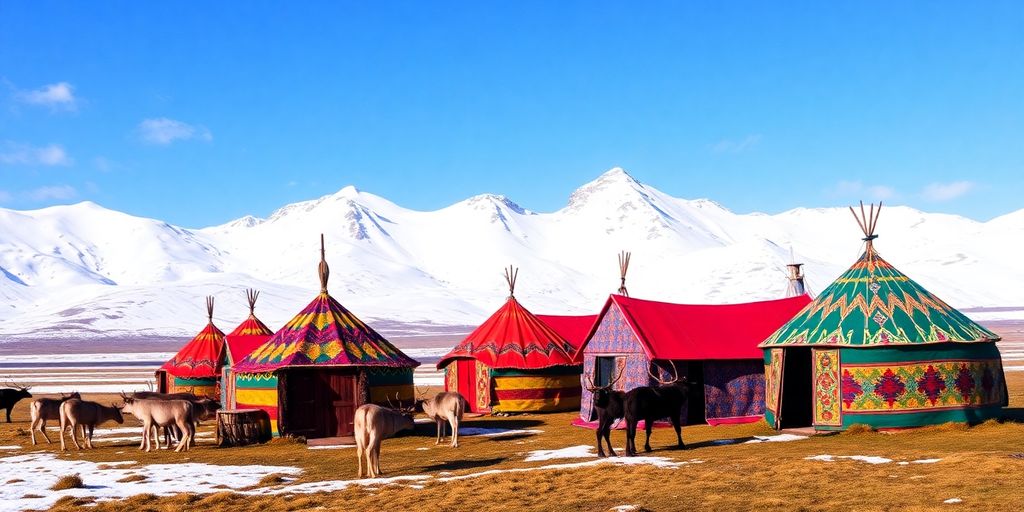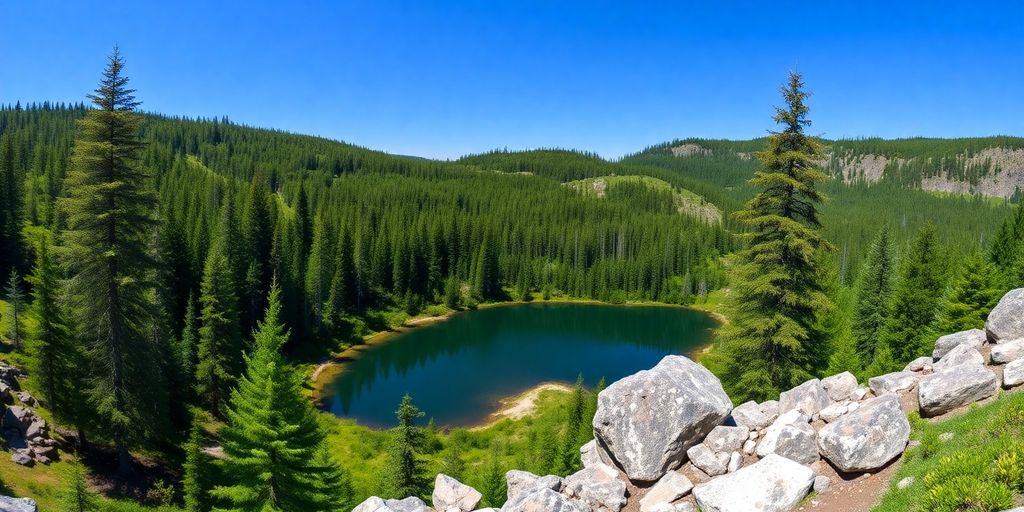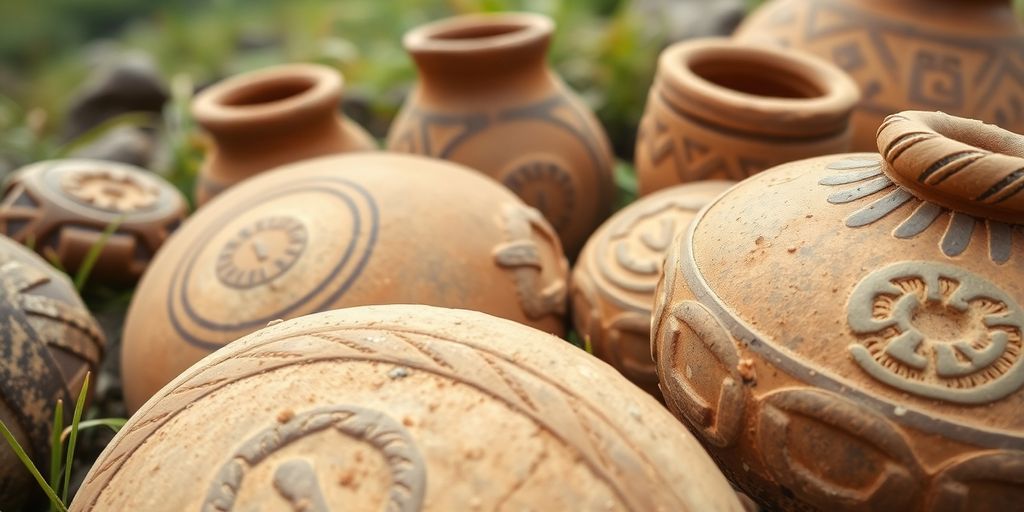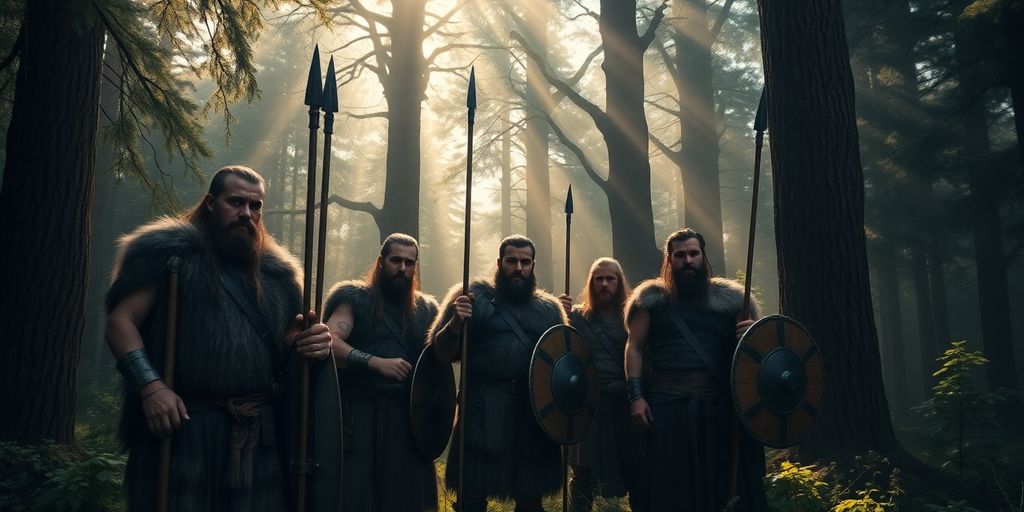Exploring the Rich Heritage and Culture of The Sami People of the North

Ever wondered about the Sami people of the north? They’re an indigenous group living across Norway, Sweden, Finland, and parts of Russia. Their culture is rich, with a history that stretches back thousands of years. From their unique traditions to their deep bond with nature, the Sami have a lot to offer. Let’s explore what makes them so special.
Key Takeaways
- The Sami have a rich history, being one of the oldest cultures in Europe, with ties to Viking ancestry.
- Joik, a traditional form of Sami music, is one of the oldest song traditions in Europe and remains popular today.
- Reindeer herding is not just a livelihood but a way of life for many Sami, reflecting their connection to nature.
- The Sami celebrate various festivals, with the Reindeer Racing Championship being a highlight of their cultural calendar.
- Efforts are ongoing to preserve the Sami language, which is central to their cultural identity.
The Historical Roots of the Sami People of the North
Ancient Origins and Migration Patterns
The Sami people, known for their deep connection to the Arctic region, have a history that stretches back thousands of years. They are believed to have settled in the Fennoscandian region between 2,000 and 2,500 years ago, long before the arrival of the North Germanic tribes. The Sami’s migration patterns were largely influenced by the natural landscapes and resources of the area, leading them to develop a semi-nomadic lifestyle centered around reindeer herding. This lifestyle allowed them to adapt to the harsh climates and move with the seasons, ensuring their survival and continuity as a unique cultural group.
Influence of Viking Ancestry
While the Sami are distinct from the Vikings, they share a historical connection through intermingled ancestry. The Vikings, known for their exploration and seafaring prowess, left a mark on the Sami culture through trade and interaction. However, unlike their Viking ancestors, the Sami have always been a peaceful people, focusing on coexistence rather than conquest. This peaceful nature has helped them maintain their cultural identity despite external influences over the centuries.
Peaceful Coexistence Through the Ages
Throughout history, the Sami have lived in harmony with their neighbors and the environment. Their ability to peacefully coexist with other cultures and adapt to changing circumstances is a testament to their resilience and wisdom. This coexistence is not just with other human societies but also with nature itself, as they have always lived in close connection with the land, respecting its cycles and resources. The Sami’s dedication to preserving their traditions and way of life, even in the face of modernization, speaks to their enduring strength and commitment to their heritage.
Cultural Expressions of the Sami People of the North
The Art of Joik: A Timeless Tradition
Joik is not just a song; it’s a heartfelt expression that captures the essence of its subject, be it a person, an animal, or a place. Considered one of the oldest music traditions in Europe, Joik is characterized by its unique melodies and emotional depth. It is a personal tribute, often performed with accompanying gestures that enhance its storytelling power. The Sami people use Joik to connect with their surroundings and their community, making it an integral part of their cultural identity.
Gakti: The Traditional Sami Attire
Gakti is more than just clothing; it’s a symbol of identity and pride among the Sami. This traditional attire is often seen at celebrations and gatherings, showcasing vibrant colors and intricate designs. Each piece of Gakti tells a story, often indicating the wearer’s heritage and social standing. The craftsmanship involved in creating Gakti is a testament to the Sami’s dedication to preserving their cultural heritage.
Duodji: The Craftsmanship of the Sami
Duodji represents the Sami’s mastery of traditional crafts, using natural materials like wood, bone, and leather. This craftsmanship is not just about creating functional items but also about art and heritage. From intricately carved knives to beautifully woven textiles, Duodji reflects the Sami’s deep connection to nature and their resourcefulness in using what the land provides. This practice is a living tradition, passed down through generations, ensuring the continuity of Sami culture.
Festivals and Celebrations Among the Sami People of the North
The Reindeer Racing Championship
Every year, the Sami community gathers for the exhilarating Reindeer Racing Championship in Kautokeino. This festival is more than just a race; it’s a vibrant celebration of Sami culture. The event is packed with concerts, exhibitions, and fun activities like scooter cross. The thrill of watching reindeer dash across the snowy landscape is unmatched. It’s a time for families to reunite, sharing stories and laughter as they cheer on their favorite racers. This event truly captures the spirit of the Sami people, blending tradition with excitement.
Easter Celebrations and Pilgrimages
For the Sami, Easter is not just a religious occasion but a cultural milestone. It marks the end of the long, dark winter and the beginning of new journeys northward for fresh pastures. Families come together, making pilgrimages that blend spiritual reflection with cultural traditions. These gatherings are filled with joy and anticipation, as families reconnect and prepare for the brighter days ahead.
The Sami Grand Prix: A Musical Extravaganza
Music is at the heart of Sami culture, and the Sami Grand Prix is a testament to this rich tradition. Held annually, this competition brings together talented singers and musicians from across Norway, Sweden, and Finland. It’s a showcase of the unique Sami art form known as Joik, one of the oldest song traditions in Europe. The event is a musical feast, celebrating the creativity and talent of the Sami people. Attendees are treated to a range of performances that highlight the deep emotional connection between the artists and their heritage.
The Sami festivals are a reflection of a community deeply connected to its roots, celebrating life through music, tradition, and the natural world. Each event is a reminder of the enduring spirit and vibrant culture of the Sami people.
For those interested in experiencing indigenous Sami art and culture, festivals like Riddu Riđđu and Márkomeannu offer a glimpse into this rich heritage.
The Sami People of the North and Their Connection to Nature

Reindeer Herding: A Way of Life
For the Sami, reindeer herding isn’t just a job; it’s a lifestyle deeply woven into their identity. This ancient practice has been passed down through generations, maintaining its significance in Sami culture. The Sami people are often seen migrating with their herds, adapting to the changing seasons, which is a testament to their resilience and adaptability. Reindeer herding is not only a source of livelihood but also a cultural cornerstone, symbolizing the harmonious relationship between the Sami and the natural world.
Sustainable Practices and Eco-Friendly Living
Long before sustainability became a buzzword, the Sami people were living in harmony with nature. Their eco-friendly practices are evident in their use of natural resources, ensuring nothing goes to waste. From utilizing every part of the reindeer to crafting with materials like wood and bark, the Sami have mastered the art of sustainable living. This commitment to the environment is not just a necessity but a reflection of their respect for the land they inhabit.
The Eight Seasons of the Sami Calendar
Unlike the conventional four seasons, the Sami recognize eight distinct seasons. This unique calendar reflects their profound connection to the environment, allowing them to adapt their lifestyle to the subtle changes in nature. Each season brings its own set of activities and traditions, highlighting the Sami’s deep understanding of their surroundings. This seasonal awareness is crucial for activities like reindeer herding, ensuring the Sami can sustain their way of life while respecting the natural cycles of the earth.
The Sami people’s connection to nature is not just about survival; it’s a profound relationship that shapes their culture, traditions, and daily lives. Living in harmony with the environment, the Sami have developed a way of life that respects and honors the natural world around them.
Their unique worldview is a testament to their enduring bond with nature, offering insights into a lifestyle that values balance and respect for all living things.
The Sami’s connection to nature is mirrored in their Christmas traditions, where the blend of animism and Christian influences reflects their deep respect for the natural world and its spiritual significance.
The Language and Communication of the Sami People of the North
Diverse Dialects and Linguistic Heritage
The Sami language is not just one language but a collection of dialects, each with its own unique characteristics. These dialects include Southern Sami, Ume Sami, Lule Sami, Inari Sami, Skolt Sami, and Northern Sami, which is the most widely spoken. Despite belonging to the same language family, these dialects are not always mutually intelligible, making communication across different Sami regions quite complex. This linguistic diversity reflects the Sami’s deep connection to their environment, with numerous words describing natural phenomena, wildlife, and weather, which are central to their traditional nomadic lifestyle.
The Role of Language in Cultural Identity
Language plays a crucial role in maintaining the cultural identity of the Sami people. It is more than just a means of communication; it is a symbol of their heritage and a link to their ancestors. The Sami language is rich in expressions that convey the subtleties of their cultural practices and beliefs. For many Sami, speaking their language is a way to keep their culture alive and to pass it on to future generations, ensuring that their traditions and history are not lost.
Preservation Efforts in Modern Times
In recent years, there has been a significant push towards preserving the Sami language, as it faces threats from modernization and historical policies that discouraged its use. Many Sami are now bilingual, speaking both their native dialect and the dominant languages of the countries they inhabit. Efforts to preserve the language include educational programs, cultural initiatives, and the use of modern technology to document and promote the language. These initiatives aim to revitalize Sami language use among younger generations, ensuring its survival in a rapidly changing world.
The Sami language is a testament to the resilience and adaptability of the Sami people. As they navigate the challenges of the modern world, their language remains a vital part of their identity, embodying their unique cultural heritage and their enduring connection to the land.
Modern Achievements and Contributions of the Sami People of the North
Prominent Sami Figures in Arts and Politics
The Sami community boasts a remarkable array of talent across various fields, from arts to politics. Many Sami individuals have become influential figures, not just within their communities but on a broader stage. In the arts, Sami singers, songwriters, and poets have made significant contributions, often using their work to express cultural identity and heritage. Politically, Sami leaders have been pivotal in advocating for indigenous rights and environmental issues, ensuring the Sami voice is heard in national and international forums.
Innovations in Sustainable Living
The Sami people have long been recognized for their sustainable practices, a necessity rooted in their close relationship with nature. In recent years, they have been at the forefront of eco-friendly innovations, combining traditional knowledge with modern technology. This includes sustainable reindeer herding practices and the utilization of natural resources in a way that minimizes environmental impact. Their approach serves as a model for sustainable living worldwide.
The Role of Women in Sami Entrepreneurship
Women in the Sami community have increasingly taken on entrepreneurial roles, driving economic development while preserving cultural heritage. Many Sami women have established businesses that focus on traditional crafts, tourism, and sustainable products, offering a unique blend of modern entrepreneurship with deep cultural roots. This not only empowers women within the community but also helps sustain Sami traditions in a rapidly changing world.
Spiritual Beliefs and Practices of the Sami People of the North

Shamanic Ceremonies and Rituals
The Sami’s spiritual world is rich with shamanic traditions. The Noaidi, or shaman, serves as a bridge between the physical and spiritual realms. These ceremonies often involve the use of a Sami drum, a vital instrument in their rituals. It’s not just about playing music; the drum is believed to summon spirits and connect the community with their ancestors. During these rituals, a sacred drink made from chaga, a non-psychedelic Arctic fungus, is shared. This drink is part of a larger ceremony that includes joik, drumming, and sometimes fire, creating a profound experience.
The Spiritual Significance of the Northern Lights
In Sami folklore, the Northern Lights are more than just a natural phenomenon; they are a spiritual experience. The Sami believe that the spirits of their ancestors dance in the sky during the long winter nights. This belief instills a sense of awe and respect for nature, as these lights are seen as a link to the past and a reminder of the Sami’s connection to the natural world.
The Sami Drum: A Ceremonial Instrument
The Sami drum is not just a musical instrument but a ceremonial tool. Each drum is unique, often adorned with symbols that hold personal or clan significance. Drumming is an integral part of Sami rituals, believed to facilitate communication with the spirit world. The rhythmic beats are thought to guide the noaidi in their spiritual journeys, offering insight and guidance to the community.
The Sami people’s spiritual beliefs offer a glimpse into a worldview where nature and the supernatural are intertwined. Their practices reflect a deep connection to the land and their ancestors, maintaining traditions that have been passed down through generations.
The Sami’s spiritual practices are deeply rooted in their mythology, emphasizing the sacred bond between their people and the natural world. This connection is evident in their reverence for natural landmarks and their oral traditions, which capture the essence of their indigenous heritage.
Wrapping Up Our Journey with the Sami
So, there you have it. The Sami people, with their rich traditions and deep connection to nature, offer a glimpse into a way of life that’s both ancient and vibrant. From their colorful festivals to their unique crafts and music, the Sami culture is a testament to resilience and creativity. Even as they embrace modernity, they hold onto their roots, ensuring their heritage thrives. Whether it’s the thrill of reindeer racing or the haunting beauty of a joik, the Sami invite us to experience a world where the past and present coexist beautifully. It’s a reminder that in our fast-paced world, there’s value in preserving the stories and traditions that shape us. So next time you find yourself in the north, take a moment to explore the Sami way of life. You might just find a piece of yourself in their story.
Frequently Asked Questions
Who are the Sami people?
The Sami are the indigenous people living in the northern parts of Norway, Sweden, Finland, and Russia’s Kola Peninsula. They have a rich cultural heritage and a deep connection to nature.
What is the traditional Sami clothing called?
The traditional clothing of the Sami is called ‘Gakti.’ It’s often worn during special occasions and is known for its bright colors and unique patterns.
What is Joik?
Joik is an ancient form of song unique to the Sami people. It’s one of Europe’s oldest song traditions and is used to express emotions or describe people, animals, and places.
How do the Sami people live today?
Many Sami people have modern lifestyles, but they still hold onto their traditions and culture. Reindeer herding remains a significant part of their livelihood.
What languages do the Sami people speak?
The Sami people speak several dialects, including Northern Sami, Southern Sami, and Lule Sami. These languages are part of the Finno-Ugric language family.
What are some Sami festivals?
Sami festivals include the Reindeer Racing Championship and the Sami Grand Prix, which celebrates their culture with music and traditional activities.








Responses